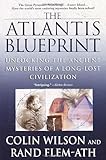
Average Reviews:

(More customer reviews)Put briefly, the premise of this book is that an advanced civilization existed in distant prehistory, sometime around 10,000 - 12,000 B.C. Its cultural center was located on what is now the continent of Antarctica and was wiped out due to a global cataclysm: a shift in the earth's pole, from a former North Pole in the Hudson Bay in Canada to the current North Pole location in the Arctic. This pole shift brought tremendous upheaval and resulted in sheets of ice covering Antarctica. These ice sheets prevent today's researchers and explorers from uncovering the strongest evidence of its existence.
The inhabitants of this civilization were technically advanced, particularly in the area of geology and possibly in other areas as well, including acoustics. In terms of geology they were able to figure out that even earlier pole shifts had occurred and, the authors surmise, were able to predict that there was another one coming that was going to wipe out most of what they had come to build. They had two goals: to create as permanent a memorial as possible to their existence and to pass along their knowledge to subsequent cultures. This memorial would encode a message to a future, advanced civilization that it, too, should be aware of the existence of pole shifts.
Wilson and Flem-Ath postulate that this ancient civilization accomplished its first goal -- memorializing their civilization -- by creating a huge network of "markers" at meaningful locations around the globe. Giza was chosen as the prime meridian, partly due to its being the geological "center of mass" of the continental array of the time. The global survey resulted in markers being placed all of the globe, at regular intervals of degrees of latitude and with orientations that pointed to the pre-shift pole location and/or to the post-shift location. Through this means they knew that a future advanced civilization -- one that also had knowledge of the earth's dimensions and poles -- would be able to interpret their message. The Great Pyramid of Giza, as the monument located at the center of world mass and on the then-prime meridian, provided the most carefully coded clues based on its dimensions and design.
As the people of this culture came into contact with the other, less advanced cultures of the time, they made a powerful impression. They were often considered to be gods or angels. As a result, their influence is expressed in a miriad of ways: as Mayan gods, angels in the Book of Enoch, Egyptian gods, etc. In addition, the sites they marked in their survey came to be considered sacred sites. This resulted in sacred temples, shrines, and buildings being erected.
"The Atlantis Blueprint" presents a remarkable overview of how sacred sites all over the world -- from Stonehenge to Easter Island -- fit into the scheme created by the lost civilization. It even shows how it has become possible to actually predict where an ancient site *should* be located, based on the blueprint, and how certain sites came to be discovered based on it. (This latter point was to me the most compelling part of the authors' presentation, since the truest test of any theory is its ability to not only explain past phenomena, but to *predict* future phenomena. Wilson and Flem-Ath's concept of the site markers provides a straightforward way to test their ideas -- if their techniques can be applied to areas of the globe where historical sacred sites have not yet been uncovered, and this results in the discovery of sites at those locations, then it adds tremendous weight to their ideas. And, indeed, this is just what happens.)
The book is entertaining and engrossing. It also provides an excellent starting point for exploring various other theories about the possible existence of this civilization, including the books by Charles Hapgood, Andrew Collins, Graham Hancock, and Robert Bauval. In some instances, Flem-Ath and Wilson provide elegant summaries of these authors' theories. (Based on this book I myself have now decided to read books by Hancock and Bauval as well as more about the Book of Enoch, the Templars, and the Mayans.)
Some points I would like to make in addition:
The book does not propose that Antarctica itself took a "voyage", or that any islands sank into the sea, but rather that the longitude of Antarctica shifted and thereby radically altered its climate.
In addition, Wilson and Flem-Ath do *not* claim that the advanced civilization actually built all of the sacred monument that exist at these important latitude locations. Instead they believe that the local inhabitants were responsible for the monuments, viewing the locations as sacred due to the fact that the revered "gods" had placed markers on them.
Also, you will notice that I have avoided using the term "Atlantis" to refer to this ancient civilization, since I think many readers may find the Atlantis association too "New Age" for comfort. Perhaps these people did refer to their home city as Atlantis, or maybe it was Plato who is more responsible for the name, but whatever the case, for me it is the possible existence of this civilization that is most important.
Finally, some readers might find it more helpful to read the Appendices *first*, then the main portion of the book. The Appendices provide some nice summaries of Wilson and Flem-Ath's theories that I probably would have liked having under my belt before I began the book.
Highly recommended to those with open minds and inquisitive natures.
Click Here to see more reviews about: The Atlantis Blueprint: Unlocking the Ancient Mysteries of a Long-Lost Civilization

No comments:
Post a Comment